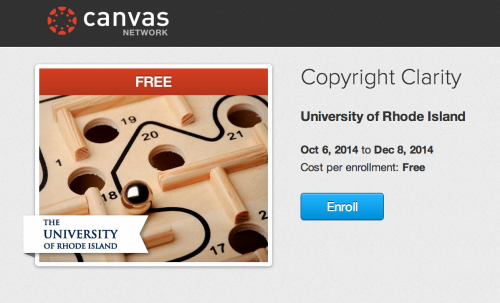Renee Hobbs and Kristin Hokanson are teaming up to offer a free MOOC on Copyright Clarity at the Canvas Network.
In this course, you will learn about the most common myths and misinformation related to copyright and fair use. You'll learn how copyright law protects both the rights of authors and audiences and about three prevailing views of copyright in relation to digital media and digital learning. You will gain practice in conducting a situational analysis to determine when you need to ask permission, buy a license, claim fair use, or use alternative licensing schemes like Creative Commons. By gaining copyright clarity, you will become an advocate to help others appreciate how fair use supports digital learning and understand the scope of our rights and responsibilities under the law.
LEARN MORE AND REGISTER HERE. Program start October 6.
This course and its materials and resources are designed for educators and educational professionals in the United States. International participants are welcome, however, your local copyright law may differ from U.S. copyright law.
Everyone deserves to have a sound understanding of copyright and fair use as a fundamental part of our legal system since copyright law affects the way we gather, share, create and use the intellectual property that is constantly being generated in our culture. By taking this course, you will enhance your confidence about how the law affects teaching and learning in a digital age. The videos, readings, lesson plans, activities and resources in this guide give educators tools to start rich conversations about the topic of copyright and fair use. These materials help educators and students understand the legal and ethical uses of copyrighted material for teaching and learning that are protected under the doctrine of fair use.
Integrating Copyright and Fair Use into Digital Learning in this course, you will learn to incorporate the topic of copyright and fair use into existing instruction, following the media literacy learning spiral of ACCESS, ANALYZE, EVALUATE, CREATE and ACT. Each lesson uses the following structure to promote the development of students’ critical thinking and communication skills.
Activate prior knowledge Each lesson begins with an opportunity to engage students by tapping into what they already know and think. In some lessons, a “Schoolhouse Rock style” educational song helps stimulates student interest and motivation.
Gain knowledge and analyze information A reading, research or information gathering activity enables students to gain access to new knowledge. Specific instructional strategies are offered to help educators support learners with different levels of knowledge and skills and check for understanding. To strengthen analysis and evaluation skills, students engage in discussion that produces divergent thinking and critical analysis.
Compose, share and act Each lesson includes an opportunity for students to produce material themselves, creating something new that allows them to reflect upon and demonstrate what they have learned. Some activities use social media or Web 2.0 resources, available free online, while others are based on more traditional literacy practices. Each lesson includes key learning outcomes that can help you assess and evaluate your learning in situational context.
